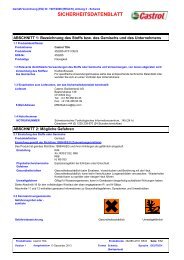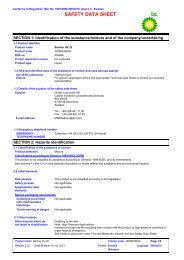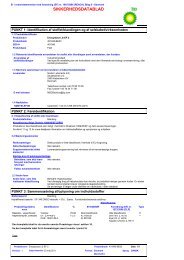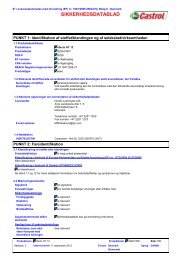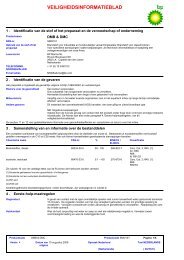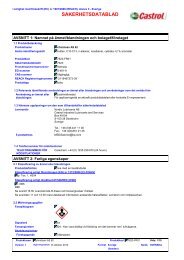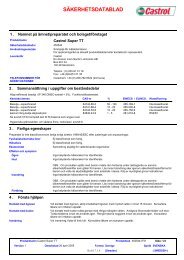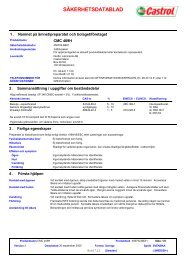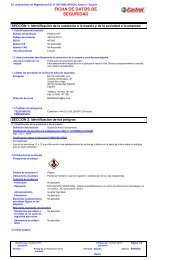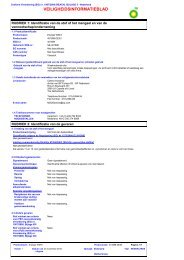(English (GB)) - BP - PDS & MSDS Search
(English (GB)) - BP - PDS & MSDS Search
(English (GB)) - BP - PDS & MSDS Search
Create successful ePaper yourself
Turn your PDF publications into a flip-book with our unique Google optimized e-Paper software.
Material Safety Data Sheet<br />
1 . Identification of the material and supplier<br />
Product name<br />
SDS #<br />
Honilo 430<br />
456870<br />
Product use Coolant lubricant<br />
For specific application advice see appropriate Technical Data Sheet or consult our company<br />
representative.<br />
Supplier<br />
EMERGENCY TELEPHONE<br />
NUMBER<br />
OTHER PRODUCT<br />
INFORMATION<br />
Product code 456870-AU01<br />
2 .<br />
Hazards identification<br />
Statement of<br />
hazardous/dangerous nature<br />
Risk phrases<br />
Safety phrases<br />
3 .<br />
<strong>BP</strong> Australia Pty Ltd (ABN 53 004 085 616)<br />
Melbourne Central,<br />
360 Elizabeth Street,<br />
Melbourne,<br />
Victoria 3000,<br />
Australia<br />
Tel: +61 (03) 9268 4111<br />
Fax: +61 (03) 9268 3321<br />
+61 2801 44558 (or 1800 14 14 74 within Australia)<br />
Technical Help Line 1 300 557 998 (Local Call)<br />
HAZARDOUS SUBSTANCE. DANGEROUS GOODS.<br />
R65- Harmful: may cause lung damage if swallowed.<br />
R66- Repeated exposure may cause skin dryness or cracking.<br />
R52/53- Harmful to aquatic organisms, may cause long-term adverse effects in the aquatic<br />
environment.<br />
S24- Avoid contact with skin.<br />
S61- Avoid release to the environment. Refer to special instructions/safety data sheet.<br />
S62- If swallowed, do not induce vomiting: seek medical advice immediately and show this container or<br />
label.<br />
Composition/information on ingredients<br />
Highly refined base oil and additives<br />
Ingredient name<br />
CAS no.<br />
Gas oil - unspecified 64742-46-7 50 - 100<br />
C14-17 chlorinated paraffin 85535-85-9 1 - 5<br />
4 .<br />
Eye contact<br />
Skin contact<br />
Inhalation<br />
First-aid measures<br />
In case of contact, immediately flush eyes with a copious amount of water for at least 15 minutes. Get<br />
medical attention if irritation occurs.<br />
Wash with soap and water. Get medical attention if irritation develops.<br />
If inhaled, remove to fresh air. Get medical attention if symptoms appear.<br />
Ingestion If swallowed, do NOT induce vomiting. Never give anything by mouth to an unconscious person.<br />
Aspiration hazard if swallowed- can enter lungs and cause damage. Obtain medical attention.<br />
Product name Honilo 430<br />
Product code<br />
Version 1 Date of issue 25 January 2007<br />
Format Au s t r a l i a<br />
Language ENGLISH<br />
Build 3.2.1<br />
(Australia)<br />
456870-AU01<br />
%<br />
Page: 1/5
5 .<br />
Fire-fighting measures<br />
Extinguishing Media<br />
Suitable<br />
Not Suitable<br />
Hazards from combustion<br />
products<br />
Unusual fire/explosion<br />
Hazards<br />
Special fire-fighting<br />
procedures<br />
Protection of fire-fighters<br />
Hazchem code 3(Y)<br />
Use foam or all-purpose dry chemicals to extinguish. This material is harmful to aquatic organisms.<br />
Fire water contaminated with this material must be contained and prevented from being discharged to<br />
any waterway, sewer or drain.<br />
Do not use water jet.<br />
These products are<br />
carbon oxides<br />
halogenated compounds<br />
This material is not explosive as defined by established regulatory criteria.<br />
None identified.<br />
6 . Accidental release measures<br />
Fire-fighters should wear self-contained positive pressure breathing apparatus (SCBA) and full turnout<br />
gear.<br />
Emergency Procedures Immediately contact emergency personnel. Keep unnecessary personnel away. Use suitable<br />
protective equipment (See Section: "Exposure controls/personal protection"). Follow all fire fighting<br />
procedures (See Section: "Fire-fighting measures").<br />
Methods and materials for<br />
containment and clean-up<br />
7 .<br />
Handling<br />
Storage<br />
Handling and storage<br />
If emergency personnel are unavailable, contain spilled material. For small spills add absorbent (soil<br />
may be used in the absence of other suitable materials) scoop up material and place in a sealed,<br />
liquid-proof container for disposal. For large spills dike spilled material or otherwise contain material to<br />
ensure runoff does not reach a waterway. Place spilled material in an appropriate container for<br />
disposal. Avoid contact of spilt material with soil and prevent runoff entering surface waterways. See<br />
Section 13 for Waste Disposal Information.<br />
Aspiration hazard if swallowed- can enter lungs and cause damage. Do not ingest. If ingested do not<br />
induce vomiting. Avoid contact with skin and clothing. Avoid contact of spilled material and runoff with<br />
soil and surface waterways. Wash thoroughly after handling.<br />
Keep container tightly closed. Keep container in a cool, well-ventilated area.<br />
Combustibility Classification Combustible liquid Class C1 (AS 1940).<br />
8 . Exposure controls/personal protection<br />
Ingredient name Occupational exposure limits<br />
Gas oil - unspecified NOHSC (Australia).<br />
TWA: 5 mg/m 3 8 hour(s). Form: Oil mist, mineral<br />
Whilst specific OELs for certain components are included in this SDS, it should be noted that other components of the preparation will be<br />
present in any mist, vapour or dust produced. For this reason, the specific OELs may not be applicable to the product and are provided<br />
for guidance purposes.<br />
Biological Limit Values No biological limit allocated.<br />
Control Measures<br />
Hygiene measures<br />
Personal protective equipment<br />
Respiratory system<br />
Skin and body<br />
Provide exhaust ventilation or other engineering controls to keep the relevant airborne concentrations<br />
below their respective occupational exposure limits.<br />
Wash hands, forearms and face thoroughly after handling chemical products, before eating, smoking<br />
and using the lavatory and at the end of the working period.<br />
Avoid breathing of vapours, mists or spray. Select and use respirators in accordance with AS/NZS<br />
1715/1716. When mists or vapours exceed the exposure standards then the use of the following is<br />
recommended: Approved respirator with organic vapour and dust/mist (Type P1) filters. Filter capacity<br />
and respirator type depends on exposure level.<br />
Avoid contact with skin. Wear suitable protective clothing.<br />
Product name Honilo 430<br />
Product code<br />
456870-AU01<br />
Version 1 Date of issue 25 January 2007<br />
Format Australia<br />
Language ENGLISH<br />
Build 3.2.1<br />
(Australia)<br />
Page: 2/5
9 .<br />
Hands<br />
Eyes<br />
Wear suitable gloves. Chemical resistant gloves. Recommended: Nitrile gloves.<br />
The correct choice of protective gloves depends upon the chemicals being handled, the conditions of<br />
work and use, and the condition of the gloves (even the best chemically resistant glove will break down<br />
after repeated chemical exposures). Most gloves provide only a short time of protection before they<br />
must be discarded and replaced. Because specific work environments and material handling practices<br />
vary, safety procedures should be developed for each intended application. Gloves should therefore<br />
be chosen in consultation with the supplier/manufacturer and with a full assessment of the working<br />
conditions.<br />
Safety glasses with side shields.<br />
Physical and chemical properties<br />
Physical state Liquid.<br />
Colour Clear. Amber.<br />
Odour Not available.<br />
Flash point 132 °C (Closed cup) Pensky-Martens.<br />
Boiling point / range<br />
Melting point / range<br />
Density<br />
Not available.<br />
Not available.<br />
Vapour density Not available.<br />
Vapour pressure<br />
813 kg/m 3 (0.813 g/cm 3 ) at 15°C<br />
Not available.<br />
Solubility Insoluble in water.<br />
pH Not available.<br />
Relative density Not available.<br />
Viscosity Kinematic: 4 mm 2 /s (4 cSt) at 40°C<br />
10 . Stability and reactivity<br />
Stability<br />
Conditions to Avoid<br />
Incompatibility with various<br />
substances/Hazardous<br />
Reactions<br />
The product is stable.<br />
Hazardous polymerization Will not occur.<br />
Hazardous Decomposition<br />
Products<br />
11 . Toxicological information<br />
Effects and symptoms<br />
Avoid extreme temperatures, strong oxidizers, fire.<br />
Reactive or incompatible with the following materials: oxidizing materials.<br />
These products are<br />
carbon oxides<br />
halogenated compounds<br />
Eyes Unlikely to cause more than transient stinging or redness if accidental eye contact occurs.<br />
Skin<br />
Slightly irritating to the skin.<br />
Inhalation At normal ambient temperatures this product will be unlikely to present an inhalation hazard because of<br />
its low volatility. May be harmful by inhalation if exposure to vapour, mists or fumes resulting from<br />
thermal decomposition products occurs.<br />
Ingestion<br />
Chronic toxicity<br />
Carcinogenic effects<br />
12 . Ecological information<br />
Ecotoxicity<br />
Biodegradability<br />
Aspiration hazard if swallowed -- harmful or fatal if liquid is aspirated into lungs.<br />
No component of this product at levels greater than or equal to 0.1% is identified as a carcinogen by<br />
ACGIH, the International Agency for Research on Cancer (IARC), the European Commission (EC), or<br />
the National Occupational Health and Safety Commission (Australia).<br />
Harmful to aquatic organisms, may cause long-term adverse effects in the aquatic environment.<br />
Persistence/degradability The biodegradability of this material has not been determined.<br />
Product name Honilo 430<br />
Product code<br />
456870-AU01<br />
Version 1 Date of issue 25 January 2007<br />
Format Australia<br />
Language ENGLISH<br />
Build 3.2.1<br />
(Australia)<br />
Page: 3/5
13 . Disposal considerations<br />
Disposal Consideration /<br />
Waste information<br />
Special Precautions for<br />
Landfill or Incineration<br />
14 . Transport information<br />
International transport regulations<br />
Avoid contact of spilled material and runoff with soil and surface waterways. Consult an environmental<br />
professional to determine if local, regional or national regulations would classify spilled or<br />
contaminated materials as hazardous waste. Use only approved transporters, recyclers, treatment,<br />
storage or disposal facilities. Dispose of in accordance with all applicable local and national<br />
regulations.<br />
No additional special precautions identified.<br />
Regulation UN number Proper shipping Class Subsidiary Packing Label<br />
name<br />
class group<br />
ADG<br />
Classification<br />
IMDG<br />
Classification<br />
IATA<br />
Classification<br />
3082<br />
ENVIRONMENTALLY<br />
HAZARDOUS<br />
SUBSTANCE,<br />
LIQUID, N.O.S.<br />
(C14-17 chlorinated<br />
paraffin)<br />
3082 ENVIRONMENTALLY<br />
HAZARDOUS<br />
SUBSTANCE,<br />
LIQUID, N.O.S.<br />
(C14-17 chlorinated<br />
paraffin). Marine<br />
pollutant<br />
3082<br />
Special precautions for user<br />
15 . Regulatory information<br />
ENVIRONMENTALLY<br />
HAZARDOUS<br />
SUBSTANCE,<br />
LIQUID, N.O.S.<br />
(C14-17 chlorinated<br />
paraffin)<br />
Standard for the Uniform Scheduling of Drugs and Poisons<br />
Additional information<br />
9 Not III Hazchem code: 3(Y)<br />
determined.<br />
Initial emergency<br />
response guide: 47<br />
9<br />
9<br />
Not<br />
determined.<br />
Not<br />
determined.<br />
III<br />
III<br />
9<br />
9<br />
9<br />
Emergency Procedure<br />
Guide:9C1<br />
Marine pollutant<br />
Severe marine pollutant<br />
(PP)<br />
Not determined.<br />
No known special precautions required. See Section: "Handling and storage" for additional information.<br />
Ingredient name Schedule<br />
Gas oil - unspecified Schedule: 5.<br />
Control of Scheduled Carcinogenic Substances<br />
Ingredient name Schedule<br />
No Listed Substance<br />
Other Classification Information<br />
Australia Regulations Labelling requirements for SUSDP do not apply to a poison that is packed and sold solely for industrial,<br />
laboratory or manufacturing use. However, this product is labelled in accordance with NOSHC<br />
National Code of Practice for labelling of workplace substances.<br />
Other regulations<br />
Inventories AUSTRALIAN INVENTORY (AICS): In compliance.<br />
CANADA INVENTORY (DSL): In compliance.<br />
CHINA INVENTORY (IECS): In compliance.<br />
EC INVENTORY (EINECS/ELINCS): In compliance.<br />
JAPAN INVENTORY (ENCS): Not determined.<br />
KOREA INVENTORY (ECL): In compliance.<br />
PHILIPPINE INVENTORY (PICCS): In compliance.<br />
US INVENTORY (TSCA): In compliance.<br />
Product name Honilo 430<br />
Product code<br />
456870-AU01<br />
Version 1 Date of issue 25 January 2007<br />
Format Australia<br />
Language ENGLISH<br />
Build 3.2.1<br />
(Australia)<br />
Page: 4/5
16 . Other information<br />
Key to abbreviations<br />
History<br />
Date of issue 25/01/2007.<br />
Date of previous issue<br />
No Previous Validation.<br />
Prepared by Product Stewardship<br />
Notice to reader<br />
AMP = Acceptable Maximum Peak<br />
ACGIH = American Conference of Governmental Industrial Hygienists, an agency that promulgates<br />
exposure standards.<br />
ADG = Australian Code for the Transport of Dangerous Goods by Road and Rail<br />
ADG Code = Australian Code for the Transport of Dangerous Goods by Road and Rail<br />
CAS Number = Chemical Abstracts Service Registry Number<br />
HAZCHEM Code = Emergency action code of numbers and letters which gives information to<br />
emergency services. Its use is required by the ADG Code for Dangerous Goods in bulk.<br />
ICAO = International Civil Aviation Organization.<br />
IATA = International Air Transport Association, the organization promulgating rules governing shipment<br />
of goods by air.<br />
IMDG = International Maritime Organization Rules, rules governing shipment of goods by water.<br />
IP 346 = A chemical screening assay for dermal toxicity. The European Commission has<br />
recommended that Method IP 346 be used as the basis for labelling certain lubricant oil base stocks<br />
for carcinogenicity. The EU Commission has stipulated that the classification as a carcinogen need<br />
not apply if it can be shown that the substance contains less than 3% DMSO extract as measured by<br />
IP 346. (See Note L, European Commission Directive 67/548/EEC as amended and adapted.) DMSO<br />
is a solvent.<br />
NOHSC = National Occupational Health & Safety Commission, Australia<br />
TWA = Time weighted average<br />
STEL = Short term exposure limit<br />
UN Number = United Nations Number, a four digit number assigned by the United Nations Committee<br />
of Experts on the Transport of Dangerous Goods.<br />
All reasonably practicable steps have been taken to ensure this data sheet and the health, safety and environmental information<br />
contained in it is accurate as of the date specified below. No warranty or representation, express or implied is made as to the accuracy or<br />
completeness of the data and information in this data sheet.<br />
The data and advice given apply when the product is sold for the stated application or applications. You should not use the product other<br />
than for the stated application or applications without seeking advice from us.<br />
It is the user’s obligation to evaluate and use this product safely and to comply with al applicable laws and regulations. The <strong>BP</strong> Group<br />
shall not be responsible for any damage or injury resulting from use, other than the stated product use of the material, from any failure to<br />
adhere to recommendations, or from any hazards inherent in the nature of the material. Purchasers of the product for supply to a third<br />
party for use at work, have a duty to take all necessary steps to ensure that any person handling or using the product is provided with the<br />
information in this sheet. Employers have a duty to tell employees and others who may be affected of any hazards described in this sheet<br />
and of any precautions that should be taken.<br />
Product name Honilo 430<br />
Product code<br />
456870-AU01<br />
Version 1 Date of issue 25 January 2007<br />
Format Australia<br />
Language ENGLISH<br />
Build 3.2.1<br />
(Australia)<br />
Page: 5/5



